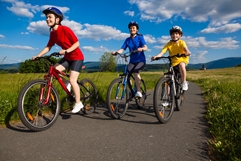
As one of the leading charity organizations in Canada, the Canadian Red Cross works to provide an essential layer of support for those in need during emergency situations.
From programs that offer food, clothing, shelter and medical assistance to those that help people gain important skills, Canadian Red Cross humanitarian aid can improve the lives of people affected by a range of hardships.
When it comes to empowering people with the knowledge and confidence to overcome challenges that may emerge following a medical incident, Canadian Red Cross first aid and CPR courses can give individuals a better understanding of what steps to take to help someone.
The following are common first aid and CPR emergencies that occur during the warmer months of the year. By having a greater awareness of how frequently these incidents occur, Canadians can better respond to the needs of people impacted by them.
Heat-related emergencies
As the temperature rises in the summer months, people may be more prone to experience emergencies such as heat cramps, heat exhaustion and heat stroke, particularly older adults and children.
Signs of a heat-related emergency can vary, but typically include feelings of nausea, dizziness, cramps or muscle tightening, rapid breathing and headaches.
People who have been trained in first aid and CPR can offer a better sense of how to react during an incident of this nature. Reaching out to emergency responders and moving someone to a cool location, then encouraging him or her to drink water in sips and get out of constrictive or tight clothing can be helpful.
Biking-related injuries
When the weather's warm, it can mean one thing for youngsters: it's time to hit the road! Taking a bike out during the sunniest days of the season can offer children a healthy outlet for activity and also encourage them to explore their imaginative sides by venturing to new destinations.
Bikes can provide kids with some of the most fulfilling and engaging times they'll spend in the summer, however, they can also put young ones at risk for becoming injured.
Falling off a bike is a dangerous and frightening scenario that can leave young ones exposed to a variety of hazards, but parents who make an effort to raise children's awareness of how to be safe on the road can prevent these situations from occurring.
"Close supervision, keeping away from busy streets and parking lots, and having adults lead by example on helmet use as well as knowing - and obeying - traffic rules will prevent injuries," said Rick Caissie, national director of of first aid, swimming and water safety with the Canadian Red Cross.
According to the Red Cross, one in 10 bicycle-related deaths or injuries are due to collisions with vehicles, while about a third of visits to the emergency room made by children with bikes are due to broken bones.
By knowing how to perform first aid and CPR, parents can treat minor scrapes and other injuries children have after falling off of bikes. This knowledge can also help for treating cuts, scrapes and wounds stemming from other outdoor injuries.
Take action
With the first aid and CPR courses available through the Canadian Red Cross, you can gain the skills to respond to heat-related incidents and treat injuries related to biking and other outdoor activities.
In addition, Canadian Red Cross first aid and CPR courses can help people gain confidence, which can be necessary in the aftermath of an emergency to ensure people react decisively.
To show your support for the Canadian Red Cross' humanitarian work, please donate online or at your local Red Cross office today. Each contribution benefits those affected by emergencies and disasters and can help the Red Cross continue its impactful programs both in Canada and abroad.